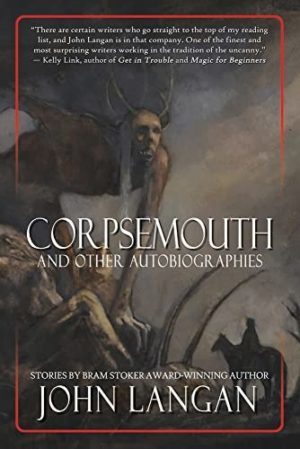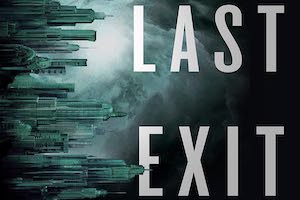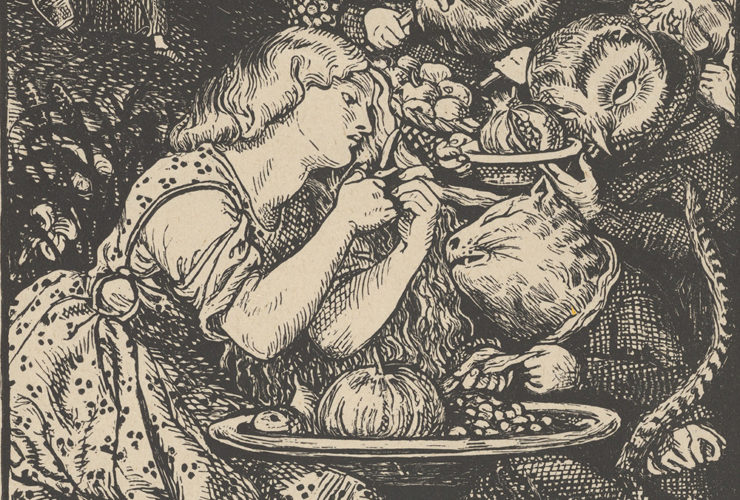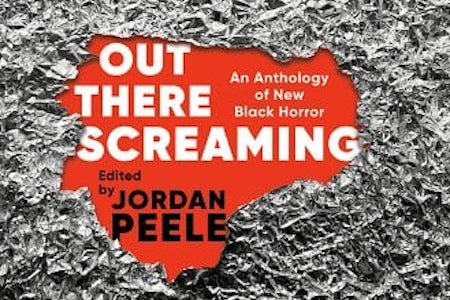Welcome back to Reading the Weird, in which we get girl cooties all over weird fiction, cosmic horror, and Lovecraftiana—from its historical roots through its most recent branches.
This week, we cover John Langan’s “Kore,” first published in the K. Allen Wood’s 2014 Shock Totem: Holiday Tales of the Macabre and Twisted anthology. You can find it most recently in Langan’s Corpsemouth and Other Autobiographies collection. Spoilers ahead!
“Oh Ancient Power,” I said, “we bring offerings for your honor. Accept them, and do not drag us down to the darkness where you reign.”
The unnamed narrator and his wife Annie have created a much-loved holiday tradition in their neighborhood. They started their “Halloween Walk” when Annie learned that some children in their son Robbie’s preschool didn’t get to trick-or-treat because their parents thought their neighborhoods unsafe. All kids should experience Halloween, so the couple transformed their backyard into a haunted space, complete with a spider-infested passage between house and garage, the hands of the dead (stuffed rubber gloves) reaching through the chain link fence, and a scarecrow Frankenstein’s monster lolling in a white resin chair. The big gag that first year was an overripe watermelon cut in half and laid at the (sleeping?) monster’s feet to represent his “old, used-up brain.” The kids had to fish keys out of his “rotten gray matter” without waking him, then dash to the front porch to redeem bags of candy from a witch, actually Annie in costume. Afterward the couple supervised the whole gang in a trick-or-treat walk down their safe street.
By popular demand from Robbie’s friends, the Halloween Walk has continued even after the couple purchased a new house. Here a large basement provides the perfect setting. The “ringmaster” narrator has led the kids through a sunken backyard door into such terrifying mysteries as Dr. Frankenstein’s laboratory (where they had to steal the batteries meant to power a new monster), Dr. Moreau’s vivisection surgery (where they had to rescue the stuffed animals he hadn’t yet mutilated into semi-humans), and Dracula’s castle (where the magic rings that could resurrect the vampire were their target). Whatever the theme, the tours end in what the real estate agent touted as a “sauna”: a small room in which a metal basket full of large stones was the only thing vaguely sauna-like. The hole in the center of the floor seems too big for a drain; the couple has decided it’s a disused dry-well, even if it’s too deep to probe with a flashlight. For safety’s sake, they’ve covered it with plywood.
This Halloween, they produce their most elaborate Walk yet: Indiana Jones meets the Mummy. They scatter sand (and fake snakes, spiders and scorpions) on the floor, along with (plastic) human bones. Narrator chalks “the most sinister hieroglyphs [he] could find online” onto the walls. In the sauna stands a six-foot long cardboard box painted to simulate a sarcophagus. For the first time, narrator makes use of the drywell, removing the cover and surrounding its rim with more “malevolent sigils.” Another first: Annie isn’t merely waiting at the end, but playing a role in the Walk proper. Her inspiration was a mythology-themed birthday party featuring a Medusa’s head piñata, left largely intact after its serpent-hair had been beaten off and its contents spilled. Annie’s repurposed it as an oversized mask, paired it with long gray gloves and a pale green Salvation Army gown, and transformed herself into a goddess. Which one, narrator asks. It doesn’t matter, Annie says. Her plan is to sit opposite the sarcophagus, statue-still like another prop, then rise to give the kids a good jump-scare. To propitiate her (no, Annie says, the goddess), narrator suggests the kids throw candy into the drywell.
Narrator worries that now Robbie’s friends are eleven, they’ll find the Walk too tame, but on the whole they get into the eerie spirit of the Pharaoh’s Tomb. In the sauna “Chamber of Souls,” Annie’s slow-rising goddess inspires a collective gasp. Robbie plays along by denying the apparition is his mom; after all, she’s waiting upstairs. He manages to sound genuinely nervous. Even the most skeptical kid tosses in his offering with apparent dread, and a tag-along younger brother is so freaked out that his mother can’t reassure him the goddess is just “Ms. Annie.” “How do you know?” he keeps demanding. “How do you know?”
Narrator expects Annie to unmask and calm the kid, but she just stands and stares through the blank eyes of the mask. He herds the kids upstairs to the kitchen, where Annie (having slipped out the basement door, circled around to the house door, and gotten into her usual witch costume) is distributing treats. “You are something,” he tells her in admiration. “You have no idea,” she says.
Buy the Book


Just Like Home
Narrator doesn’t think much of that night until after Thanksgiving. Waking in the middle of the night, he senses something different. Annie’s not in the bedroom, or to be heard downstairs. But in the darkest corner stands a figure in the oversized head and gown of Annie’s goddess. He goes icy with fear, somehow certain this is not Annie disguised—the darkness around it seems “grainier…as if the air were different,” giving the “impression of tremendous distance and age.” After a long staring silence, while the boy’s “How do you know?” loops through narrator’s mind, the figure exits soundlessly. Driven by alarm for Annie and Robbie, narrator forces himself to search the house.
Robbie’s sound asleep in his room. Narrator finally finds Annie in the basement “sauna,” crouched naked over the drywell, around which she’s added some sigils of her own. Hair hanging around her face, she drops candies one by one into the well. Narrator approaches her, stunned speechless. Without looking up or speaking, she hands him a candy. He gazes into the blackness “that dropped who knew how far to who knew what destination.” “You have no idea,” Annie said Halloween night, and narrator doesn’t.
But he tosses his offering into the well, and reaches to Annie for the next one.
What’s Cyclopean: Simple, straightforward descriptions of the Walk’s props—just like the props themselves, until they become something more.
The Degenerate Dutch: Some neighborhoods just aren’t safe for trick-or-treating.
Weirdbuilding: The Halloween Walk covers every genre of corny horror, from Frankenstein’s lab to Dracula’s castle to Dr. Moreau’s island to Indiana Jones Meets the Mummy.
Libronomicon: Did someone say Frankenstein, Dracula, and The Island of Doctor Moreau? But probably the movie versions.
Madness Takes Its Toll: No madness this week. Probably.
Anne’s Commentary
A search for haunted attractions in my area netted twenty, ranging from modest fundraising events and old-school hayrides through major theme parks like Spooky World. Micro-haunts like the one in “Kore,” amateur-designed for private parties, must number in the hundreds, providing revenue for those Halloween pop-ups that sprout in strip malls this time of year like orange-and-black mushrooms of questionable toxicity. How deadly can plastic skeletons and fake-fur bats and Styrofoam gravestones be? Even the pro haunts, featuring elaborate sets and actors in film-ready makeup, require a willing suspension of disbelief, along with a desire to be terrified for the thrill of it.
Safely terrified. Nobody wants real zombies stalking their haywagon, or real demented clowns chasing them with real chainsaws.
Or real chthonic goddesses, right? How long are rock-hard Charleston Chews going to satisfy a real goddess?
Langan’s title, stark and unlikely to spark instant recognition, is a master stroke. I figured “Kore” was someone’s name and pressed on, expecting an eventual explanation. None is stated outright, but the implication is clear. Somehow this normal couple living in a nice safe neighborhood has summoned a dark deity to their basement sauna, if sauna it ever were. A dark deity named Kore, I assumed, and so on to Google.
Kore, it turns out, is a wireless group, and also a manufacturer of utility belts, and also a distributor of Korean streetwear. A longish scroll down: In classical Greek statuary, “kore” refers to the standing figure of a young female, robe-draped rather than nude. “Kore” in Greek means “maiden,” and “Kore” is another name for Persephone, in Greek mythology the daughter of Zeus and Demeter and part-time underworld Queen. Kore may be Persephone’s birth name, associated with her role as the goddess of vegetation, nature and the seasons of growth; as Persephone, she’s associated with her role as Mrs. Hades, co-ruler of the dead. Along with Demeter, she’s central to the Eleusinian Mysteries, a long-lived secret cult with agrarian origins and aspirations of immortality.
Kore’s quite the divine celebrity to provide kids’ party entertainment in lieu of a face-painter. That’s if it is Kore in the sauna on Halloween night, with Langan delivering his punchline right there in the title.
It’s a pleasing puzzle to unravel, from clues easily overlooked on the first read-through. Maybe it doesn’t mean anything that it’s Annie who suggests the Halloween Walk, or that she always wears a witch costume, or that the first time she actually performs is as a goddess ex drywell. Maybe it’s random inspiration that makes her convert the Medusa piñata into a goddess mask. Or—maybe the mask triggers her desire to summon what lies below, to give it a physical shell to inhabit. Shades of Klein’s Nadelman’s God! If you have no god, or goddess, create one.
Alternatively, this goddess may already exist, only without a mundane form. Former worshippers—the ones who used that stone-loaded metal brazier for more than generating steam—have moved away. A potential new priestess moves in. The goddess takes time, several Halloween’s worth, to influence her. Then the stars, or the costume and scenario, align. Annie becomes cryptic. The narrator asks why she wants the piñata. “You’ll see,” Annie answers. He asks which goddess she is. “That’s not important,” Annie replies.
Of course it’s important, but Annie knows her husband will overlook the omission in his enthusiasm. He’s the one who suggests throwing candy into the drywell to propitiate “you.” “Not me,” Annie corrects. “The goddess.”
The narrator has worried that Robbie’s friends have outgrown their amateurish staging. Halloween night, he’s gratified when even the group skeptic looks unsettled. He attributes the tension to his son’s playing along with the scenario, even when Robbie sounds “genuinely nervous,” claiming that the sauna-specter doesn’t look like his mom, and besides, she’s upstairs. The collective anxiety escalates as the youngest boy refuses to participate in the propitiation offerings, trembling in unfeigned terror. He doesn’t buy that the goddess is Annie, repeatedly insisting “How do you know?” Later his mother admits that she too was creeped out. “Your wife is some actress,” she says.
Annie is upstairs before the narrator, even though as he himself describes it, she had a much more circuitous route to follow. She’s even managed to shed her goddess costume for the usual witch gear. “You are something,” he says. “You have no idea,” she replies. It’s a loaded statement that he passes over without question.
Then comes the night after Thanksgiving, and an uncanny encounter that narrator can’t dismiss as Annie pranking him. How much has he sensed but suppressed up to the moment he finds her naked by the drywell, casting candy into unfathomed depths? His reaction reads more like resignation to the truth than like shock. Resigned, too, is the unquestioning manner in which he joins her in propitiation, recalling how the Charleston Chew he tosses is kin to one that broke his loose baby tooth years back, flooding his mouth with both blood and sugar.
This memory, no throwaway flashback, provides climactic irony. Eating that childhood Chew both injured and gratified the narrator, merging pain and pleasure. Tossing the Chew as an adult merges the pain of subjugation with—what pleasure?
The pleasure of subjugation, of surrender? Religion, this yearning for higher powers than oneself, powers benign or monstrous or both in one, is a complicated thing.
Ruthanna’s Commentary
Halloween is a kaleidoscope of a holiday. Turn it, and ancient acknowledgment of the dying year twists into modern inversion festival, twists into a satanic night of power existing only in the minds of the terrified, twists into a reclaimed Samhain where old gods are renewed. Turn it, and the fleeing prey of the wild hunt become laughing trick-or-treaters become the gothiest possible dancers to debauch a midnight ball. Turn it, and costumes morph from protection against spirits, to boast-worthy craft projects, to expressions of innermost self, to opportunities to play with what you’ve never been, to sexy fill-in-the-blanks, to tools for invoking and becoming… something.
And then there’s the “haunted house.” Is it going to be as absolutely real as Hill House, or fake as a cheesy roadside attraction? You decide! Or not.
Because the liminal power of Halloween, after all, is that it could be real. Never mind that you know it’s all sheets and cardboard boxes and store-bought costumes, that you saw those tissue-paper ghosts dangling from that tree in broad daylight and that skeletal spider on sale at Walmart. The night is dark and the wind is chill, and the leaves crunch underfoot. Flashlights cast long shadows down the sidewalk. In the dark, after the door closes, trying to decide whether you can handle just one more block, anything you glimpse in the corner of your eye just might be truth.
I love how Langan handles this blurring transformation. The most wholesome of Halloween traditions, beloved by friends, growing over the years into one of those labors of love that make neighbors worthwhile. Narrator has no malice in him; he just wants to give kids something fun to do and a safe place to go trick-or-treating. And it’s worked for years. In this house, even. Finishing up in the same weird sauna room, with the same bottomless pit in the floor… though never before using that pit.
Maybe some houses start haunted, and others learn. Or maybe Annie has previously stuck to the end of the festivities for a reason. Was she always… something… or did the piñata-turned-mask spark something new?
There’s a hint in the title. Kore isn’t just any goddess—she’s the goddess who’s taken to the underworld by Hades, and becomes Persephone. Less innocent, more powerful. And still someone who can change with the turning year, who can show a different face above in the light from the one seen below in the darkness. Annie (nee Inanna?) has gone down to the underworld/basement, and changed.
That does mean, of course, that she was always a goddess. “You are something.” “You have no idea.”
That frightened kid has an idea, or at least the edge of one. So does the skeptical kid. Skepticism can be brittle, a mask waiting to be cracked (piñata-like). As another take on Hades and Persephone suggests, “doubt creeps in.” And doubting the world you thought rational can be much more frightening than just being afraid in the first place.
Better throw some cheap chocolate into that bottomless pit, just in case. Propitiate… something. Even if you don’t have any way to know.
Next week, we continue N. K. Jemisin’s The City We Became with Chapter 12: They Don’t Have Cities There. Let’s see what Aislyn thinks about this whole teamwork thing…
Ruthanna Emrys’s A Half-Built Garden is now out! She is also the author of the Innsmouth Legacy series, including Winter Tide and Deep Roots. You can find some of her fiction, weird and otherwise, on Tor.com, most recently “The Word of Flesh and Soul.” Ruthanna is online on Twitter and Patreon, and offline in a mysterious manor house with her large, chaotic, multi-species household outside Washington DC.
Anne M. Pillsworth’s short story “The Madonna of the Abattoir” appears on Tor.com. Her young adult Mythos novel, Summoned, is available from Tor Teen along with sequel Fathomless. She lives in Edgewood, a Victorian trolley car suburb of Providence, Rhode Island, uncomfortably near Joseph Curwen’s underground laboratory.













